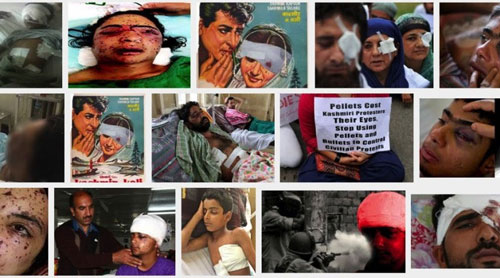Humayun Aziz Sandeela
Indian severity in illegally occupied Jammu and Kashmir is anything but a new phenomenon however, the use of pellet guns (a type of shotgun) has added another dimension to it. Pellet guns are not used elsewhere on the planet accept in IIOJK which obviously shows the Indian mentality of using it as an instrument of torment to suppress the voice of the Kashmiris.
Being marked for the third time since it was officially designated by the UN General Assembly, the World Braille Day on 04 January 2021 brings issues to light of the significance of the tactile global communication system, which empowers blind and visually impaired people, to understand their full human rights. It is assessed that roughly 2.2 billion individuals have vision impairment or visual deficiency, as indicated by the Worth Health Organization (WHO), a billion of whom have either not had their condition tended to, or whose impedance might have been forestalled. Individuals with vision debilitation are more probable than those without, to encounter higher paces of destitution and burden. Not meeting their needs, or fulfilling their rights, has far-reaching consequences: vision loss often represents a lifetime of inequality, poorer health, and barriers to education and employment. However, the situation in IIOJK is totally different as Indian forces are deliberately blinding the Kashmiri people to suppress their ongoing liberation struggle.
Pellet guns are used for hunting animals across the world. But in IIOJK, Indian troops have been using this weapon against innocent Kashmiris. Pellet guns were first used by the Indian police in IIOJK in 2010 for controlling protesters as a “non-lethal” alternative to other deadlier weapons. However, in 2010, 14-year-old Irshad Ahmad Parray and 20-year-old Mudasir Nazir lost their lives to pellet gun injuries. These “non-deadly” weapons have caused serious injury and serious damage to many Kashmiris so far. Indian occupational forces are continuously maiming, blinding, and killing the Kashmiris by using these guns.
Since 2010, every two in ten casualties have been executed by pellet guns, yet these firearms are viewed as the better alternative, a “non-deadly” decision to control protests. Human Rights Watch in one of its reports pointed out that 17 individuals were killed because of the use of pellet guns between 2015 and 2017.
It also mentioned that the pellets discharged from shotguns blinded 139 individuals between July 2016 and February 2019. According to Research Section of Kashmir Media Service, from 2016 till October 2020, 10,500 civilians have been injured due to use of pellet guns, 139 people have been blinded, 210 lost their eyesight in one eye while vision of 200 people was damaged partially. In January 2018, Mehbooba Mufti, the then chief minister of IIOJK, told the so-called Assembly of IIOJK that 6,221 individuals had been injured by pellets between July 2016 and February 2017 and 782 of those had eye injuries.
In total infringement of international laws, the Indian government is violating international standards with its response to protests in IIOJK. In particular, New Delhi is violating the UN Basic Principles on the Use of Force and Firearms by Law Enforcement Officials and the UN Code of Conduct for Law Enforcement Officials. The basic principles state that, “Law enforcement officials (must) apply non-violent means before resorting to the use of force”. Additionally, provision five states, “whenever the lawful use of force and firearms is unavoidable, law enforcement officials shall: (a) exercise restraint in such use and act in proportion to the seriousness of the offence… (b) minimize damage and injury… (c) ensure that assistance and medical aid are rendered to any injured or affected person at the earliest moment…” However, in Kashmir, restriction isn’t being worked out, injury isn’t being limited and clinical help isn’t guaranteed. Pellet firearms are not a proportional reaction to the protests. A great deal of harm has been perpetrated, especially including individuals’ vision, far too many bystanders, including kids, have been harmed and clinical help comes just at the danger of being captured and arraigned.
The pellet guns cartridges fire an enormous number of little pellets over a wide reach. Indeed, even the inspector general of the Jammu and Kashmir police recognized that pellets don’t have an anticipated direction.
The United Nations Basic Principles 13 and 14 discuss the methods to disperse protests, stating, “in the dispersal of assemblies that are…non-violent, law enforcement officials shall avoid the use of force” and “in the dispersal of violent assemblies,—Kashmir Media Services










